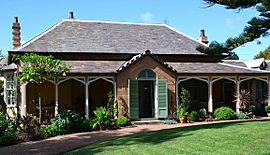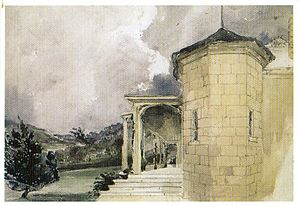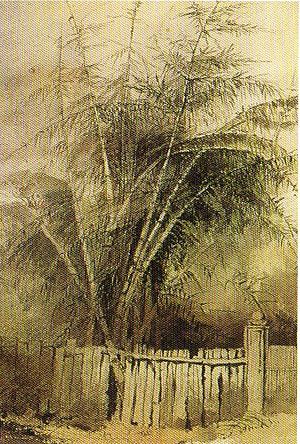Bronte House facts for kids
Quick facts for kids Bronte House |
|
|---|---|
 |
|
| General information | |
| Status | Complete |
| Type | House |
| Architectural style | Australian Gothic Revival |
| Location | Bronte, New South Wales |
| Country | Australia |
| Coordinates | 33°54′08″S 151°15′51″E / 33.9023°S 151.2643°E |
| Named for | Duke of Bronte, Horatio Nelson |
| Construction started | 1838 |
| Completed | 1845 |
| Owner | Waverley Municipal Council |
| Technical details | |
| Material | Sandstone; slate; internal timber joinery; marble |
| Design and construction | |
| Architect |
|
| Known for | House and garden settings in the Gothic picturesque style |
| Renovating team | |
| Architect | Clive Lucas |
| Other designers |
|
| Official name | Bronte House; Bronte estate |
| Type | State heritage (complex / group) |
| Designated | 2 April 1999 |
| Reference no. | 00055 |
| Type | Other - Landscape - Cultural |
| Category | Landscape - Cultural |
Bronte House is a beautiful historic home in Bronte, Australia. It's listed as a heritage site, meaning it's important to keep and protect. Built between 1843 and 1845, this house shows off the Australian Gothic Revival style. It was designed by Georgiana & Robert Lowe and Mortimer Lewis.
This "magnificent, mid-Victorian mansion" is made of sandstone. It has one main floor with verandahs (covered porches) on the west and east sides. You'll also notice a service wing and two cool octagonal (eight-sided) rooms with cone-shaped roofs. The house and its gardens are known for their "Gothic picturesque style," which means they look like something out of a romantic painting.
Today, Waverley Municipal Council owns Bronte House. It's leased to private tenants who help maintain the house and gardens. They also open it to the public a few times each year, so everyone can enjoy its history and beauty.
Contents
A Look at Bronte House History
Bronte House has a long and interesting story. It's one of the oldest buildings in Sydney's eastern suburbs.
How Bronte Got Its Name
The suburb of Bronte is named after this very house! The house was named by an early owner, Robert Lowe, to honor Horatio Nelson. Nelson was a famous admiral in the British Navy. In 1799, the King of Naples made Lord Nelson the Duke of Bronte. Bronte is a town in Sicily, Italy.
Old records show that the area was first called Nelson Bay. Roads were also named after Nelson. Over time, Nelson Road became Bronte Road. But the name Nelson Bay still appears on official maps today.
Building the House
The story of Bronte House began in 1836. Colonial Architect Mortimer Lewis bought a large piece of land near Nelson Bay. He bought about 12 acres, including the beach front. By 1838, he owned 42 acres, covering the valley, creek, and headlands.
Lewis chose the perfect spot for the house. He started building around 1838. But in 1843, due to money problems, Lewis had to sell the unfinished house. He sold it for A£420 to a lawyer named Robert Lowe.
Robert Lowe and his wife, Georgiana, finished building the house in 1845. Georgiana Lowe was a talented artist and gardener. Her drawings show us what Bronte House and the area looked like back then. She also created the first famous gardens at Bronte House.
The Lowes lived in the house for four years. Robert Lowe was a member of the New South Wales Legislative Council. In 1849, the Lowe family sold Bronte House and moved back to England. Robert Lowe later became a very important politician there.
Who Lived Here After the Lowes?
After the Lowes, Bronte House had several owners. In 1861, Joseph B. Holdsworth bought the house. He added a second floor to one part of the house.
The Ebsworth family owned Bronte House for over 60 years, from 1882 to 1948. They were wool brokers. In 1935, they even tried to get the NSW Government to buy the house.
After World War II, the Australian Red Cross used parts of the house as offices. In 1948, Waverley Municipal Council bought Bronte House. They wanted to turn the valley leading to Bronte Beach into a public park.
For a while, the house was used for weddings and parties. But it started to fall apart. In 1983, the Council came up with a clever plan. They decided to lease the house for a very low rent (just $1 a year!). In return, the tenants had to pay for big repairs and open the house to the public several times a year.
Christopher Selmes was the first tenant under this plan. He spent a lot of money restoring the house. Later, arts organizer Leo Schofield took over the lease in 1994. He continued the restoration work on both the house and the garden.
Since 2001, landscape designer Myles Baldwin has helped guide the garden's look. Today, Bronte House is still owned by Waverley Council and leased to private tenants. It remains open to the public on special days.
Exploring Bronte House and Its Gardens
Bronte House is special because of how it sits in its natural surroundings. The formal garden blends beautifully with the wilder Bronte Gully. This creates a romantic, picturesque feel.
The Amazing Garden
The garden was first designed by Georgiana Lowe in the 1840s. It sits at the top of a small valley that goes down to Bronte Beach. Even though parts of the garden have changed over the years, important sections, like the natural rock formations, are still there.
- Early Features: The garden once had a carriage loop where a Norfolk Island pine was planted. Georgiana Lowe also created an elaborate rockery garden. She had an orchard and vegetable garden in the lower valley.
- Special Plants: You can still find some very old plants here. There's a huge clump of giant bamboo that Georgiana Lowe likely planted herself. Two magnificent pines, a Cook's pine and a Norfolk Island pine, were probably planted when the garden was very new. Bananas, sketched by Mrs. Lowe, still grow there today.
- A "Botanical Collection": The garden was once called "one of the finest botanical collections in the colony." Georgiana Lowe loved her garden. She wrote letters about planting seeds from famous expeditions. Her sketchbook, with drawings of the house and garden, is kept at the State Library of New South Wales.
- Restoration Efforts: The garden was neglected for many years. But thanks to people like Leo Schofield and Myles Baldwin, it has been brought back to life. They've uncovered old features like a circular fountain from 1886. They've also planted many new and interesting plants suitable for the coastal conditions.
The House's Unique Style
Bronte House is designed in a "picturesque" style. This means it looks like a beautiful scene from a painting.
- Gothic Details: It has romantic circular and hexagonal towers called turrets. You'll see deep bay windows and fancy carved wooden patterns on the verandahs. These Gothic details, like pointed arches, make it look different from simpler Georgian buildings.
- A "Cottage Ornee": Experts describe Bronte House as a "cottage ornee." This means it's an ornamental cottage, not a huge mansion. It was designed as a romantic escape from busy city life. It's a great example of the "Gothick taste" that was popular in the late 1700s and early 1800s.
- Design Inspiration: The design might have been inspired by a book called Rustic Architecture from 1840. The house has a main rectangular shape with a high double roof, originally made of shingles. It has verandahs on the east and west sides.
Changes Over Time
Bronte House has seen many changes since it was first built.
- Land Size: The property started at 12 acres, grew to 42 acres, and then was subdivided. Today, the most important part, including the natural rock formations, still remains.
- Additions: In the late 1800s, a second storey was added to the south side of the house. Some verandahs were enclosed to create more rooms.
- Restoration Work: In the 1980s, major restoration work began. This included fixing walls, adding bathrooms, and restoring the exterior stonework. The garden was also replanted following a plan by James Broadbent.
- Recent Updates: More restoration work continued from 1994 to 2000. New paths were added, and many new plants were introduced. This included different types of lilies, palms, and succulents. The goal was to create a "small scale botanic garden" with rare and beautiful plants.
Bronte House is a fantastic example of how old buildings can be preserved and enjoyed today. It's a reminder of Sydney's early history and the people who shaped it.
Early Residents
Here are some of the families and groups who have lived in or owned Bronte House:
| Owner / Resident | Period |
|---|---|
| Robert and Georgina Lowe | 1843–1849 |
| George Alfred Lloyd | 1853 |
| J Lublin | 1853–1854 |
| John James Falconer | 1854–1861 |
| Joseph B Holdsworth and family | 1861–1882 |
| Stanley Ebsworth and family | 1882–1948 |
| Waverley Council | 1948–present |
Thanks to extensive restoration work in the 1980s, Bronte House looks amazing today. It is the oldest known home still standing in the Waverley Council area.
Images for kids





